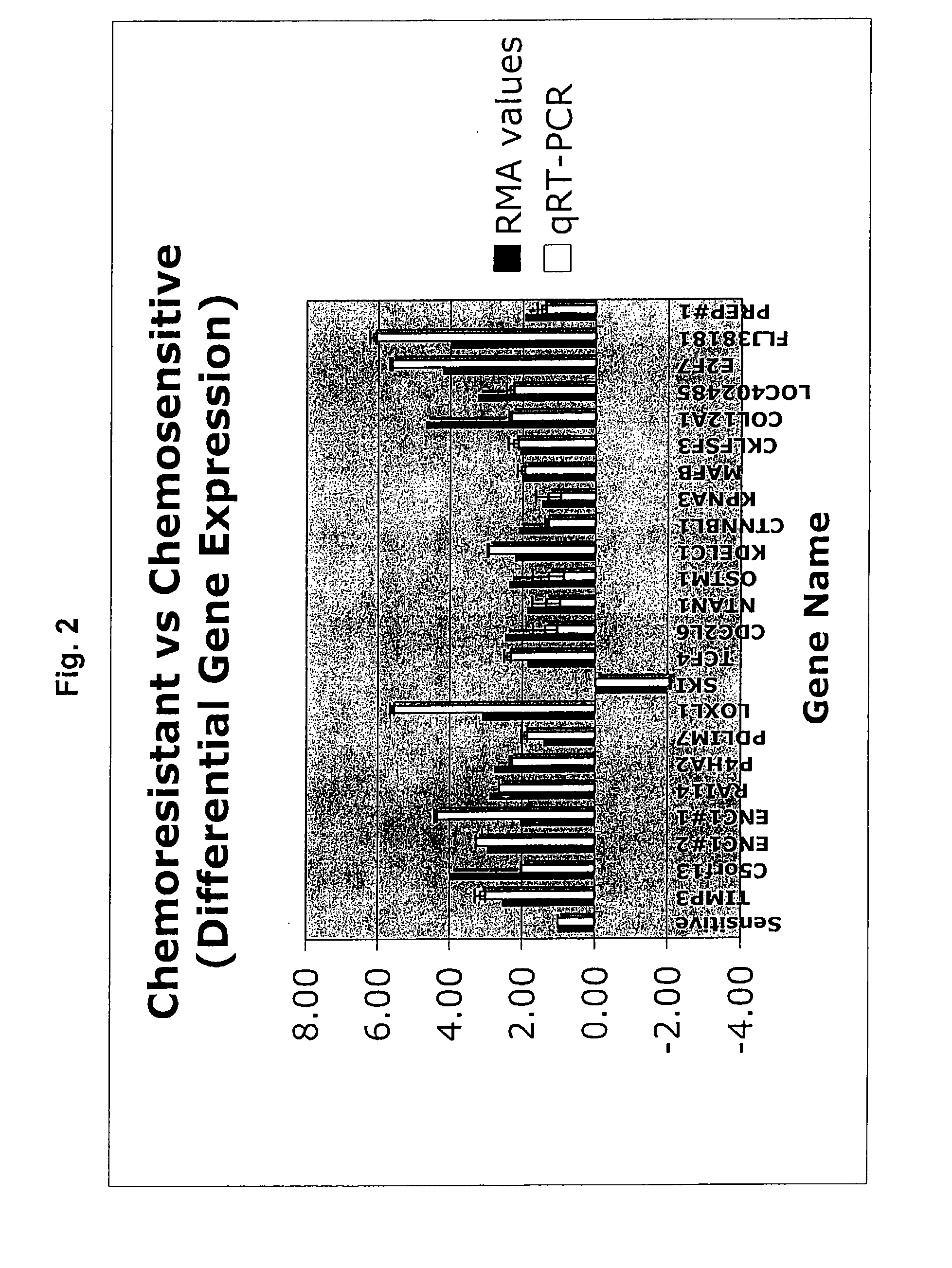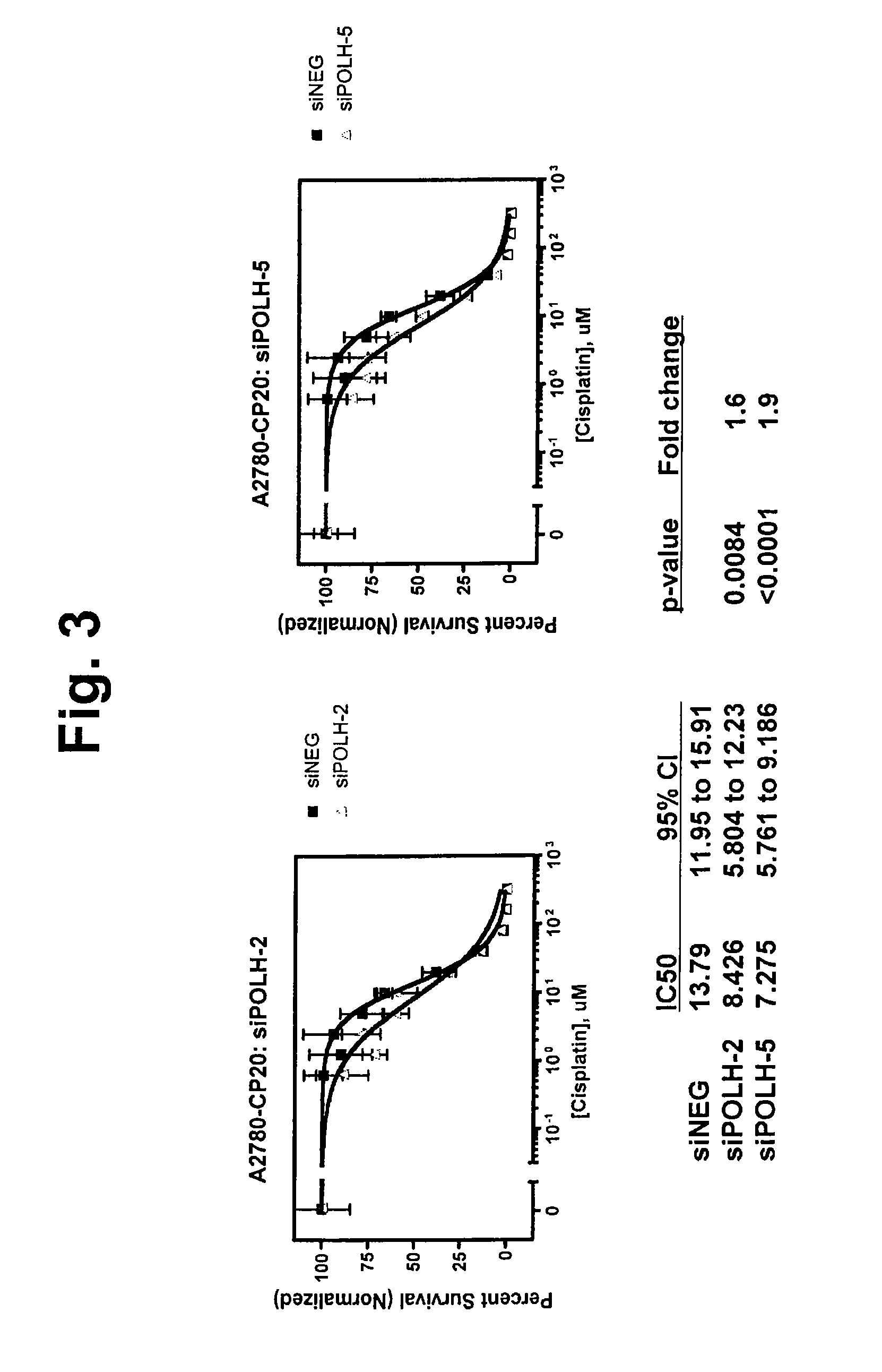Gene expression profile that predicts ovarian cancer subject response to chemotherapy
a gene expression profile and ovarian cancer technology, applied in the field of cancer chemotherapy, can solve the problem that the subject may not respond in a sufficient manner to the chemotherapeutic agent, and achieve the effects of increasing the sensitivity of ovarian cancer, reducing and increasing the sensitivity of the chemotherapeutic agen
- Summary
- Abstract
- Description
- Claims
- Application Information
AI Technical Summary
Benefits of technology
Problems solved by technology
Method used
Image
Examples
example 1
Materials and Methods
[0266]Tissue specimens. Tumor specimens were obtained from 52 previously untreated ovarian cancer subjects hospitalized at the Brigham and Women's hospital between 1990 and 2000. All of the specimens were obtained from primary ovarian tumors. Classification was determined according to the International Federation of Gynecology and Obstetrics (FIGO) standards.
[0267]Microdissection and RNA isolation. Frozen sections (7 μm) were affixed to FRAME Slides (Leica, Germany), fixed in 70% alcohol for 30 seconds, stained by 1% methylgreen, washed in water and air-dried. Microdissection was performed using a laser microdissecting microscope (Leica, Germany). Approximately 5,000 tumor cells were dissected for each case. RNA was isolated immediately in 65 μl RLT (Guanidine Isothiocyanate) lysis buffer and was extracted and purified using the RNEASY® Micro Kit according to the manufacturer's protocol (QIAGEN®, Valencia, Calif.). Total RNA was subsequently isolated using the R...
example 2
Development of Chemorefractory Gene Signature
[0276]This example describes methods used to identify 105 chemorefractory specific molecules that can be used to predict chemoresponsiveness, such as chemorefraction, in subjects with ovarian cancer.
[0277]The training set to develop the predictive refractory to chemotherapy gene signature (refractory gene list) included 12 subject samples whose tumors were refractory to chemotherapy and 13 subject samples whose tumors were sensitive to chemotherapy. The list was refined to include only genes used in all LOOCV iterations. This refinement yielded a 105-gene signature list as illustrated in Table 1. The function and / or location of the respective molecules are provided in Table 2. Genes with a positive t-statistical value are up-regulated in chemorefractory ovarian tumors and genes with a negative t-statistical value are down-regulated.
TABLE 1Chemorefractory gene signature profile.AFFYMETRIX ®t-ParametricFold ChangeUniGeneLocusLinkPROBE IDval...
example 3
Development of Predictive Chemoresistant Gene Signature
[0281]This example provides methods used to identify 31 chemoresistant specific molecules that can be used to predict chemoresponsiveness, such as chemoresistance, in subjects with ovarian cancer.
[0282]The training set to develop the predictive chemoresistant gene signature (resistant gene list) comprised of 10 subject samples whose tumors were resistant to chemotherapy and 13 subject samples whose tumors were sensitive to chemotherapy. The list was refined to include only genes used in all LOOCV iterations. This refinement yielded a 31-gene signature list as shown in Table 5. The function and / or location of the respective genes are provided in Table 6.
TABLE 5Chemoresistant gene signature profile.Fold ChangeUniGeneAFFYMETRIX ®ParametricinIDGENELocusLINKPROBE IDp-valueRESISTANTNumberSYMBOLIDGENE Name1566512_at0.000246−1.523091423Hs.159711GNG42786Hypothetical proteinLOC200169201147_s_at0.0003152.548387097Hs.297324TIMP37078TIMP met...
PUM
| Property | Measurement | Unit |
|---|---|---|
| Fraction | aaaaa | aaaaa |
| Fraction | aaaaa | aaaaa |
| Fraction | aaaaa | aaaaa |
Abstract
Description
Claims
Application Information
 Login to View More
Login to View More - R&D
- Intellectual Property
- Life Sciences
- Materials
- Tech Scout
- Unparalleled Data Quality
- Higher Quality Content
- 60% Fewer Hallucinations
Browse by: Latest US Patents, China's latest patents, Technical Efficacy Thesaurus, Application Domain, Technology Topic, Popular Technical Reports.
© 2025 PatSnap. All rights reserved.Legal|Privacy policy|Modern Slavery Act Transparency Statement|Sitemap|About US| Contact US: help@patsnap.com



